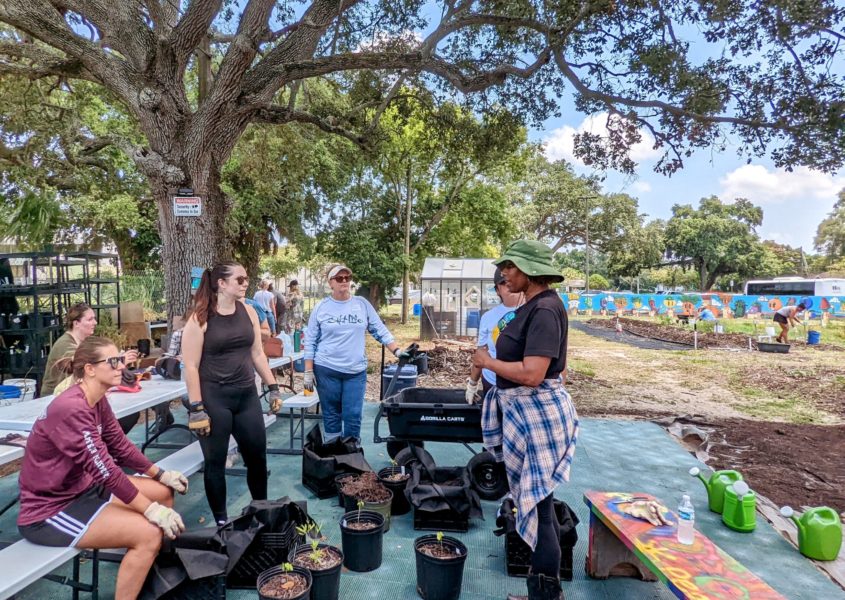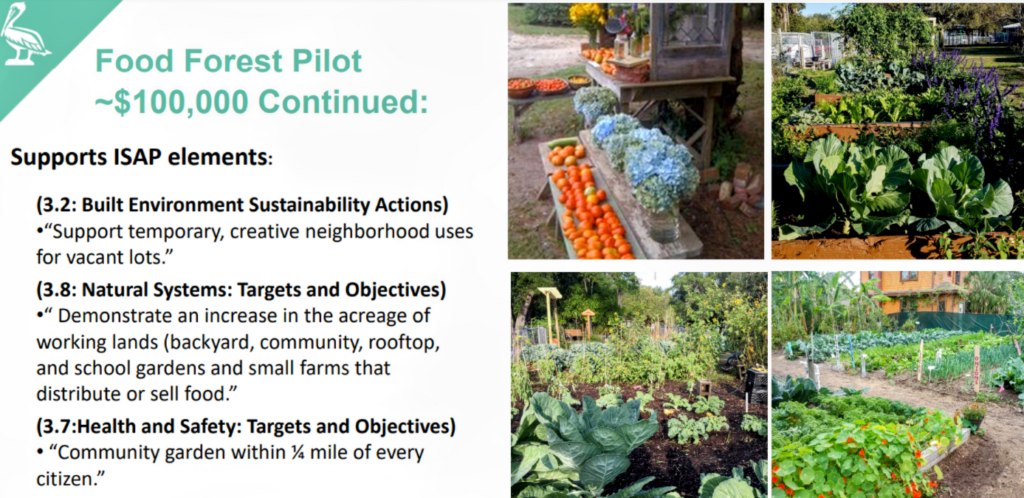Thrive
St. Pete to see more trees, food forests

While the Deepwater Horizon oil rig exploded over 13 years ago, St. Petersburg residents will continue seeing positive environmental impacts funded by the city’s settlement money.
In April 2010, the drilling platform caught fire and sank into the Gulf of Mexico, about 40 miles off the Louisiana coast. The tragedy resulted in 11 deaths and the largest marine oil spill in recorded history.
BP (formerly British Petroleum) settled for over $20 billion, with St. Petersburg initially receiving about $6.5 million. City council members heard a plan to use the final $1.063 million payment to improve St. Petersburg’s tree canopy, food forests and community gardens at the Aug. 24 Committee of the Whole meeting.
The goal is for St. Petersburg’s tree canopy to cover 30% of the city. However, spending the bulk of the funding – $850,000 – on a study, rather than providing residents with saplings, was a source of contention.
“My goal is always to just get trees in the ground,” said Councilmember Ed Montanari. “We got to be smart about it; we don’t want to just put trees anywhere. But that’s just a tough number to go along with.”
Nearly 85% of the funding would help city staff inventory over 150,000 trees around roadways and parks. An independent firm would conduct the study, saving the city over $250,000.
City officials would also allocate $100,000 for a Food Forest Pilot to support six existing gardens and establish new locations. Those will sprout from the Childs Park neighborhood and other properties in the South St. Pete Community Redevelopment Area (CRA).
The city council will formally vote on the initiative at an upcoming meeting. While multiple council members expressed their desire to see the $850,000 go towards planting trees in yards, they also realize that more information is needed to ensure the program’s success.
“This is what we use that type of funding for – one-time larger expenditures,” said Councilmember Copley Gerdes. “I would love for it to be a lot lower. But it’s also $850,000 that doesn’t have to come out of the general fund … I would rather focus general fund dollars on funding trees; getting trees into the ground.”
Allison Mihalich, sustainability and resilience director, said shade can reduce ambient temperatures by about 20 degrees. She also noted that her department must avoid interfering with sidewalks and underground utilities when planting saplings.
Geographic information system-based (GIS) mapping and analysis is a key project component. Mihalic said the city would have to hire a GIS specialist and spend over $1.5 million to complete the project in-house.
“In addition to doing something really innovative in … green infrastructure or urban agriculture, we’re going to better understand the ins and outs,” Mihalic explained. “So that we don’t have rodent issues, and we don’t have decomposing mangoes laying about the food forest.”

A graphic highlighting food forest program objectives. Screengrab.
Dean Hay, senior urban forestry specialist, is leading efforts to improve the city’s tree canopy at the neighborhood level. He has inventoried over 4,000 trees in the last 18 months.
Hay said stakeholders need exponentially more data to know what areas need more trees and how close officials are to reaching the 30% coverage goal. “That’s something that I think we need to aggressively go after,” Montanari added.
Mihalic explained that the study would also determine the health and vulnerability of existing trees. City officials must still select a firm, and Mihalic said the cost could come under budget.
Hay said a volunteer tree-planting program would begin in September. He hopes to establish a model to reduce future costs by half or a third.
“We keep bumping up against not having enough data to know whether a shade tree is even possible,” Hay said.
The Food Forest Pilot will provide $10,000 to $20,000 for neighborhood associations, churches or schools to establish or expand food forests and community gardens. Applicants must attend a training course and donate 25% of their harvest to the community.
Mihalic said program officials have notified eight neighborhood associations of their intent to proceed. She expects to spend about half the $100,000 settlement funding on those projects.
Ensuring organizations can properly maintain gardens is another program focus. Council Chair Brandi Gabbard noted that the St. Pete Youth Farm is a local success story, and said its youth ambassadors could potentially provide community education.
“So much of the urban agriculture work is about changing the culture for the next generation,” Gabbard added. “The great thing about a food forest is that it does not only feed people, but it gives that shade as well.”








Nancy E Dinucci
August 31, 2023at11:01 am
I am very happy to hear that St Pete is going to expand its tree cover, food forests. It is definitely needed and will help in so many ways. I understand the need to have a plan on where to plant trees to avoid issues and make best decision on where to plant. But the amount for the study seems excessive. How did you come up with the $850,000 amount for the study? Can you show us (the residents) the breakdown of how you arrived at this excessive amount? I think we deserve to know the details of how you arrived at this number. I wish it had been published in this article. That is almost 85% of the total budget. The goal should be to cut that amount in half at least. If you go to get bids from the companies that will do the study, they already know what you have budgeted and will take full advantage of that. How long will this study take? How much are they being paid per hour on this? Have you consulted several other cities to see how they have approached the refurbishing of their trees and forest? You could learn from their mistakes and successes and save our city money on the survey so that we have more money for the actual trees and forests. Another way to increase the number of trees in the area with out the city spending money is to require all the new buildings going up to increase the number of trees they need to plant and have them pay for a survey for their area. Many of them only plant bushes when we need more trees for shade cover.
Danny E White
August 30, 2023at1:22 pm
I the previously announced volunteer tree planting project was not rolled out as well as it could have been because of its application process complexity and its reliance on sponsoring associations to nurture the trees after installation. What happened to the master tree planting plan that brought tons of trees to thoroughfares in areas like Greater Pinellas Point? Who’s paying for that? Perhaps the best use of the spill money would be to invest in the highly successful St Pete Youth Farm to expand its operations and facilities. The Farm is a model for the entire city, where youth ambassadors learn and earn money that helps enhance their lives. Starting gardens all over the city would be very risky because they rely on committed community volunteers; the Farm already has these attributes.
Karl Nurse
August 29, 2023at5:41 pm
If you used drones and/or goggle maps, you could get this done well enough to use must of the money to actually plant trees. Police in Washington DC used to estimate crowds by taking photos from the sky, dividing it into a grid and counting a few grids, etc.
This reminds me of several dozen transit plans which cost taxpayers tens of millions of dollars. Then, implementing less than 10% of them.
Kristine Kraus
August 28, 2023at5:26 pm
What an innovative and forward thinking approach to solving long term community issues! Well done, St. Pete!